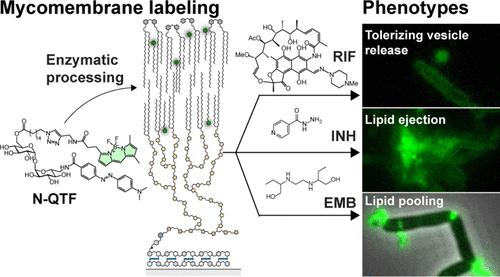当前位置:
X-MOL 学术
›
J. Am. Chem. Soc.
›
论文详情
Our official English website, www.x-mol.net, welcomes your feedback! (Note: you will need to create a separate account there.)
Fluorogenic Probes of the Mycobacterial Membrane as Reporters of Antibiotic Action
Journal of the American Chemical Society ( IF 14.4 ) Pub Date : 2024-06-21 , DOI: 10.1021/jacs.4c00617 Michael G Wuo 1 , Charles L Dulberger 2, 3 , Theodore C Warner 1 , Robert A Brown 4 , Alexander Sturm 5 , Eveline Ultee 6 , Zohar Bloom-Ackermann 5 , Catherine Choi 5 , Junhao Zhu 2 , Ethan C Garner 3 , Ariane Briegel 6 , Deborah T Hung 5, 7, 8 , Eric J Rubin 2 , Laura L Kiessling 1, 4
Journal of the American Chemical Society ( IF 14.4 ) Pub Date : 2024-06-21 , DOI: 10.1021/jacs.4c00617 Michael G Wuo 1 , Charles L Dulberger 2, 3 , Theodore C Warner 1 , Robert A Brown 4 , Alexander Sturm 5 , Eveline Ultee 6 , Zohar Bloom-Ackermann 5 , Catherine Choi 5 , Junhao Zhu 2 , Ethan C Garner 3 , Ariane Briegel 6 , Deborah T Hung 5, 7, 8 , Eric J Rubin 2 , Laura L Kiessling 1, 4
Affiliation

|
The genus Mycobacterium includes species such as Mycobacterium tuberculosis, which can cause deadly human diseases. These bacteria have a protective cell envelope that can be remodeled to facilitate their survival in challenging conditions. Understanding how such conditions affect membrane remodeling can facilitate antibiotic discovery and treatment. To this end, we describe an optimized fluorogenic probe, N-QTF, that reports on mycolyltransferase activity, which is vital for cell division and remodeling. N-QTF is a glycolipid probe that can reveal dynamic changes in the mycobacterial cell envelope in both fast- and slow-growing mycobacterial species. Using this probe to monitor the consequences of antibiotic treatment uncovered distinct cellular phenotypes. Even antibiotics that do not directly inhibit cell envelope biosynthesis cause conspicuous phenotypes. For instance, mycobacteria exposed to the RNA polymerase inhibitor rifampicin release fluorescent extracellular vesicles (EVs). While all mycobacteria release EVs, fluorescent EVs were detected only in the presence of RIF, indicating that exposure to the drug alters EV content. Macrophages exposed to the EVs derived from RIF-treated cells released lower levels of cytokines, suggesting the EVs moderate immune responses. These data suggest that antibiotics can alter EV content to impact immunity. Our ability to see such changes in EV constituents directly results from exploiting these chemical probes.
中文翻译:

分枝杆菌膜的荧光探针作为抗生素作用的报告者
分枝杆菌属包括结核分枝杆菌等物种,它可以引起致命的人类疾病。这些细菌具有可以重塑的保护性细胞膜,以促进它们在充满挑战的条件下生存。了解这些情况如何影响膜重塑可以促进抗生素的发现和治疗。为此,我们描述了一种优化的荧光探针 N-QTF,它报告霉菌基转移酶活性,这对于细胞分裂和重塑至关重要。 N-QTF 是一种糖脂探针,可以揭示快速和缓慢生长的分枝杆菌物种的分枝杆菌细胞包膜的动态变化。使用该探针监测抗生素治疗的后果发现了不同的细胞表型。即使不直接抑制细胞被膜生物合成的抗生素也会引起明显的表型。例如,暴露于 RNA 聚合酶抑制剂利福平的分枝杆菌会释放荧光细胞外囊泡 (EV)。虽然所有分枝杆菌都会释放 EV,但只有在存在 RIF 的情况下才能检测到荧光 EV,这表明接触该药物会改变 EV 含量。暴露于 RIF 处理细胞衍生的 EV 的巨噬细胞释放较低水平的细胞因子,表明 EV 调节免疫反应。这些数据表明抗生素可以改变 EV 含量从而影响免疫力。我们能够看到电动汽车成分的这种变化,直接源于利用这些化学探针。
更新日期:2024-06-21
中文翻译:

分枝杆菌膜的荧光探针作为抗生素作用的报告者
分枝杆菌属包括结核分枝杆菌等物种,它可以引起致命的人类疾病。这些细菌具有可以重塑的保护性细胞膜,以促进它们在充满挑战的条件下生存。了解这些情况如何影响膜重塑可以促进抗生素的发现和治疗。为此,我们描述了一种优化的荧光探针 N-QTF,它报告霉菌基转移酶活性,这对于细胞分裂和重塑至关重要。 N-QTF 是一种糖脂探针,可以揭示快速和缓慢生长的分枝杆菌物种的分枝杆菌细胞包膜的动态变化。使用该探针监测抗生素治疗的后果发现了不同的细胞表型。即使不直接抑制细胞被膜生物合成的抗生素也会引起明显的表型。例如,暴露于 RNA 聚合酶抑制剂利福平的分枝杆菌会释放荧光细胞外囊泡 (EV)。虽然所有分枝杆菌都会释放 EV,但只有在存在 RIF 的情况下才能检测到荧光 EV,这表明接触该药物会改变 EV 含量。暴露于 RIF 处理细胞衍生的 EV 的巨噬细胞释放较低水平的细胞因子,表明 EV 调节免疫反应。这些数据表明抗生素可以改变 EV 含量从而影响免疫力。我们能够看到电动汽车成分的这种变化,直接源于利用这些化学探针。
















































 京公网安备 11010802027423号
京公网安备 11010802027423号